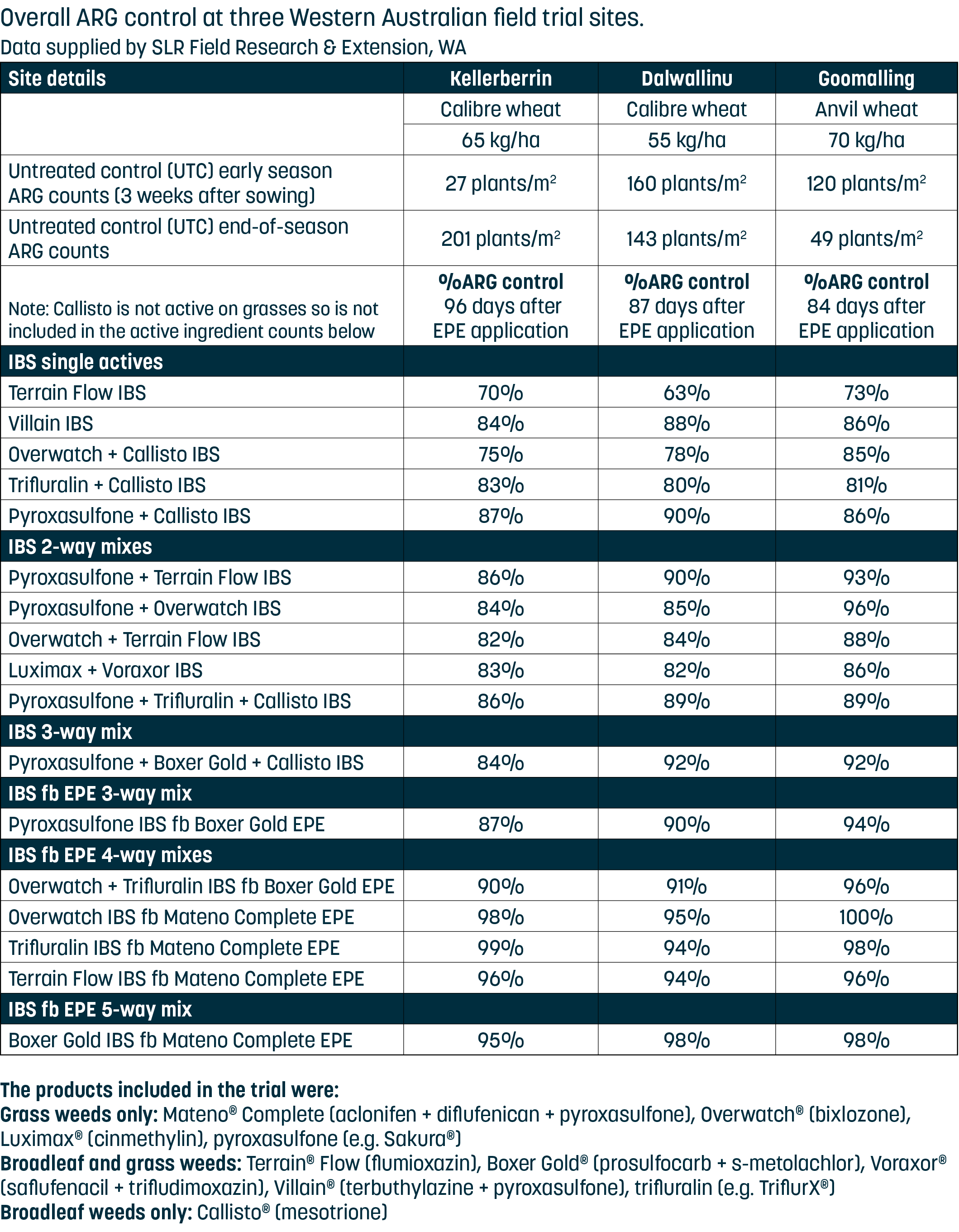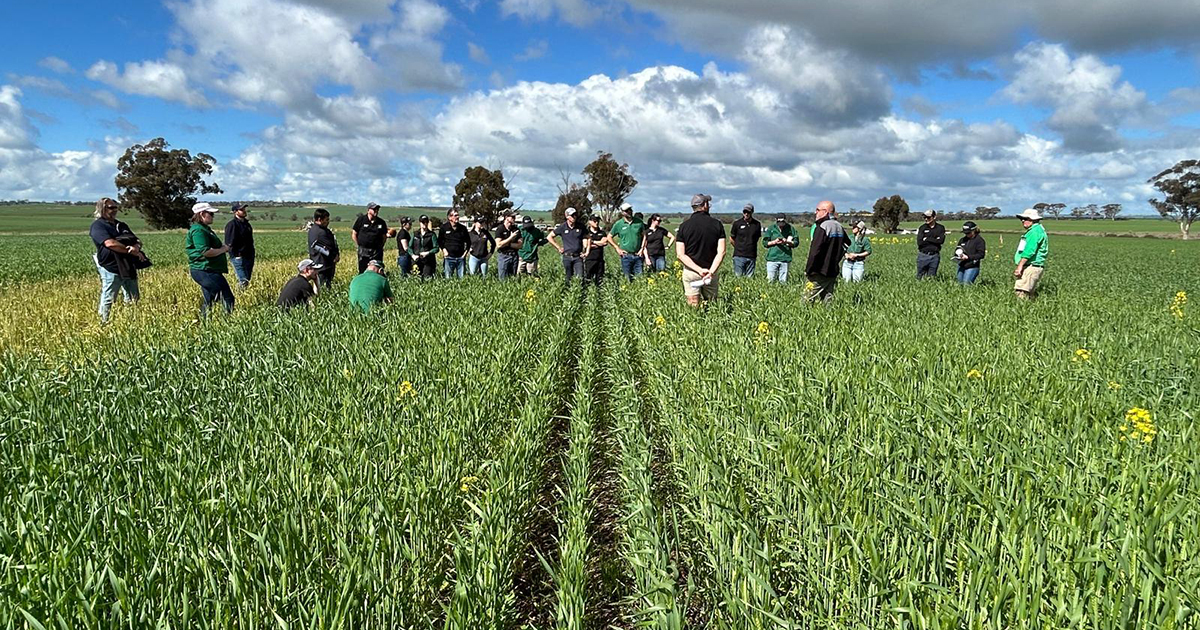Field-testing pre-emergent herbicide packages
The ‘mix-and-rotate herbicides’ strategy is central to sustainable herbicide use on Australian grain farms. It is the opposite of the ‘silver-bullet’ approach, which has repeatedly failed and resulted in the loss of valuable chemistry in many farming systems.
For the last four years, private research and extension group, SLR has conducted Showpiece Project evaluation trials comparing the best pre-emergent and early post-emergent herbicide strategies against annual ryegrass (ARG) and wild radish at field sites in Western Australia. The project connects crop protection companies with agronomists and growers, showcasing products side by side in real farm conditions. Growers see product performance first-hand, and the trials create valuable discussion across the industry.
In 2024, SLR research agronomist Louise Fraser led the trials hosted on farms at Dalwallinu, Goomalling and Kellerberrin, comparing a wide range of commonly-used herbicides in a variety of treatments with pre-emergent herbicide incorporated by sowing (IBS) either on its own or followed by (fb) pre-emergent herbicide applied early post-emergent (EPE).
SLR’s CEO research agronomist, Michael Lamond, says that the trial sites have a range of weed control mixtures with both weed efficacy and crop safety notes taken during the growing season to generate a benefit matrix of dollars-return and cost.
“This matrix shows the benefit of weed control versus the cost of the various herbicide mode of action combinations,” he says. “The grower can then weigh up the options that best suit their individual paddocks, giving thought to weed density and herbicide resistance profile, potential yield and future crops in the rotation.”
WeedSmart’s western extension agronomist, Peter Newman, says these trials demonstrate the benefit of applying mixes of multiple modes of action to control a cohort of weeds. He says the tactic is so valuable that herbicide companies are increasingly investing in bringing proprietary mixes to market.
“We generally want to see at least 97 per cent control of annual ryegrass to drive down the weed seed bank and maintain low weed numbers,” he says. “Pre-emergent herbicides are an important part of achieving this high-level control, and growers are investing heavily in early-season weed control, backed up with strong crop competition and effective control of survivors at the end of the season.”
Peter says that the main take-home messages from these trial results are:
- paddocks with lower weed seed banks can be maintained with mixes that include two or three pre-emergent actives applied at sowing, provided the crop is competitive and survivors are controlled
- paddocks with higher weed seed bank numbers will most likely need a more complex mix of pre-emergent herbicides, potentially applied both at sowing and post-crop emergence
- a reminder that pre-emergent herbicide efficacy can vary considerably, due to numerous application effects and environmental factors, and must not be relied on too heavily.
- products that offer early post emergent (EPE) use pattern extend the length of residual control of annual ryegrass, improving the overall level of control
- effective management of the weed seed bank demands the use of multiple tactics implemented throughout the cropping season. Use the WeedSmart Big 6 strategy to build a sustainable and responsive weed management program.
The Kellerberrin site provides an insight into the importance of robust pre-emergent herbicide packages in high weed pressure paddocks. The weed seed bank at Kellerberrin was the highest of the three 2024 season trial sites, based on the number of annual ryegrass plants present in the untreated control plots at the end of the season. At this site, Calibre wheat was sown at a rate of 65 kg/ha into gravelly sand with moisture at 10 mm depth, on 13 May, 2024 along with IBS applications of pre-emergent herbicide treatments.
Three weeks after planting, annual ryegrass (ARG) numbers were assessed, with 27 ARG/m2 present in the untreated control (UTC). All the pre-emergent treatments applied at sowing made a significant difference to the weed density compared to the control, keeping the ryegrass numbers to less than 5 ARG/m2, with no significant differences between herbicide treatments. This indicates the pre-emergence herbicide treatments applied at sowing reduced ARG emergence by around 82 per cent at this early crop growth stage. On the same day, 5 June, the early-post-emergent (EPE) treatments were applied.
Fifteen days after the EPE treatments were applied, all treatments were assessed for ARG density. The UTC had 146 ARG/m2, and all herbicide treatments had 45 ARG/m2 or less (at least 70% control). Trifluralin IBS fb Mateno Complete EPE (98% control) and Boxer Gold IBS fb Mateno Complete EPE (97% control) were the best performers, followed by Terrain Flow IBS fb Mateno Complete EPE (96% control). Next were Overwatch + Trifluralin IBS fb Boxer Gold EPE and Overwatch IBS fb Mateno Complete EPE at 93 and 92 per cent control, respectively. Visual crop phytotoxicity effects were observed in most EPE treatments and a few IBS-only treatments at this crop stage.
ARG numbers were assessed again 46 days after the EPE treatments were applied. At this stage (9.5 weeks after planting), the UTC had 110.22 ARG plants/m2 as crop competition began to take effect. All herbicide treatments continued to provide some control, with the top-performing treatments maintaining 95 to 99 per cent control.
At this stage, crop safety was assessed by measuring biomass reduction, which ranged from zero to 11 per cent. The IBS Villian treatment caused the greatest reduction in crop biomass. Most of the top-performing treatments for weed control also caused some reduction in crop biomass, around 3 to 8 per cent, except Overwatch + Trifluralin IBS fb Boxer Gold EPE, which did not cause any reduction in crop biomass, even though visual phytotoxicity effects were observed.
The final round of ARG counts was done 17 weeks after planting. In the UTC the ARG population had increased to 201 plants/m2. All herbicide treatments provided at least 70 per cent control. The IBS fb Mateno Complete EPE treatments provided the best control, ranging from 95 to 99 per cent. The 3-way IBS Overwatch + Trifluralin mix fb Boxer Gold EPE provided 90 per cent control. Villian IBS continued to cause biomass reduction of 11 per cent, while all other treatments had grown through any crop safety effects.
All treatments provided high-level control of the wild radish.
The trial was harvested in mid-November. All herbicide treatments significantly improved yield by 0.7 to 1.7 t/ha or 22 to 55 per cent over the UTC yield (3.08 t/ha).
Similar results were recorded at the Dalwallinu and Goomalling sites.




